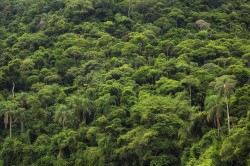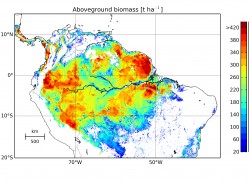Press Release, 08. November 2019
The forests of the Amazon are an important carbon sink
Innovative combination of forest models with satellite data provide more precise estimates
The world’s tropical forests store huge quantities of carbon in their biomass and thus constitute an important carbon sink. However, current estimates of the amount of carbon dioxide stored in tropical forests of the Amazon vary largely. Scientists at the Helmholtz Centre for Environmental Research (UFZ) have developed an approach that uses recent satellite data to provide much more precise estimates of the amount of biomass in tropical forests than in the past. This makes it possible to obtain a more exact picture of the consequences of droughts and forest fires for the Amazon, according to their article in the Nature Communications journal.

Photo: R-M-Nunes_Shutterstock

Photo: Rödig et al., Global Ecol Biogeogr. 2017
Estimating forest biomass from satellite measurements is still a challenge, as there exists currently no direct measurement method. State-of-the-art satellites equipped with laser or radar instruments now open up a new range of options: they not only measure the height of the forests around the globe but also the entire structure of these forests. The forest modelling team led by Prof. Dr. Andreas Huth of the UFZ now combined the measurements from a laser satellite with the FORMIND forest model developed at the UFZ; this model uses climate and soil data to simulate the dynamics of forests and the growth of individual trees with a resolution of up to 20 metres. Over 700,000 such laser datasets were evaluated in this way for the Amazon rainforest. The result: important forest attributes, which are crucial in providing a picture of a forest area, can be estimated much more accurately in future. These forest attributes include the above-ground biomass and the rate of forest growth (i.e. gross primary production). "All in all, the uncertainty surrounding the estimates of the forest parameters decreases by between 20 and 43 percent. The estimate of above-ground biomass, for example, has become 25 percent more accurate," says Andreas Huth, one of the authors of the study. This makes it possible to obtain a significantly more precise assessment of the quantity of carbon stored in the forest. "With our approach, we are able to find out more about the carbon cycle - how much is stored in the tropical rainforest, released or resorbed again each year," adds Dr. Rico Fischer, also author of this study and involved in forest modelling at the UFZ.
The UFZ team will also use the new approach to refine their own studies, which only incorporated the forest height to date but not all the information on forest structure, in their biomass estimates. In 2018, they succeeded in simulating the biomass of all 410 billion trees in the Amazon region for the year 2005 by combining laser data from the ICESat satellite with FORMIND. According to one result provided by this method, a total of 76 billion tonnes of carbon is stored in the Amazon rainforest. "This also enabled us to identify which areas of the Amazon region are carbon sinks or sources of carbon," says Andreas Huth. Overall, the rainforest still constitutes a carbon sink by absorbing around 600 million tonnes per year. There are, however, also local carbon sources, such as when trees die due to drought or are destroyed by fire.
Combining high-resolution satellite data with the FORMIND model now opens up a range of new options for the forest modelling team at the UFZ. For example, the GEDI (Global Ecosystem Dynamics Investigation) mission launched by NASA has been using a new type of laser instrument at the International Space Station (ISS) to measure the global forest since 2018. This data will be available at the end of this year. This would enable UFZ researchers to make statements at six-monthly intervals on how land use or global warming - to name just two factors - has changed the quantity of biomass stored in the tropical forests and where the carbon sinks and sources are located. Up-to-date assessments of the consequences of forest fires, such as those in the Amazon region, are also feasible. "As soon as the NASA measurements are available, we will be able to analyse how much carbon dioxide was emitted by fires in the Amazon," says Rico Fischer.
Another vision held by UFZ researchers is to integrate the data provided by other satellites and to blend it with FORMIND. This would further reduce the uncertainties contained in the estimates. Researchers could also benefit from a new radar satellite mission proposed and planned by German scientists, the Tandem-L mission. One of the mission's objectives is to measure the structure of forests around the world every week by deploying two radar satellites. This would make it possible to quickly identify changes to the forest over the short term caused by deforestation, forest fires or droughts, for example, and thus to quantify much more precisely the consequences of land use and climate change. This, according to Rico Fischer and Andreas Huth, would be a further big step for ecological research.
Publications:
Rödig et al. (2019): From small-scale forest structure to Amazon-wide carbon estimates. Nature Communications 2019, DOI: 10.1038/s41467-019-13063-y
https://www.nature.com/articles/s41467-019-13063-y
Rödig et al. (2018): The importance of forest structure for carbon fluxes of the Amazon rainforest. Environmental Research Letters. DOI:10.1088/1748-9326/aabc61 https://iopscience.iop.org/article/10.1088/1748-9326/aabc61
Further information
Prof. Dr. Andreas Huth
UFZ Department Ecological Modelling
Phone: +49 341 235-1719
andreas.huth@ufz.de
Dr. Rico Fischer
UFZ Department Ecological Modelling
Phone: +49 341 235 48 2267
rico.fischer@ufz.de
UFZ press office
Susanne Hufe
Phone: +49 341 6025-1630
presse@ufz.de
In the Helmholtz Centre for Environmental Research (UFZ), scientists conduct research into the causes and consequences of far-reaching environmental changes. Their areas of study cover water resources, ecosystems of the future, environmental technologies and biotechnologies, the effects of chemicals in the environment, modelling and social-scientific issues. The UFZ employs more than 1,100 staff at its sites in Leipzig, Halle and Magdeburg. It is funded by the Federal Government, Saxony and Saxony-Anhalt.
www.ufz.deThe Helmholtz Association contributes to solving major challenges facing society, science and the economy with top scientific achievements in six research fields: Energy; Earth and Environment; Health; Key Technologies; Matter; and Aeronautics, Space and Transport. With some 39,000 employees in 19 research centres, the Helmholtz Association is Germany’s largest scientific organisation.
www.helmholtz.de